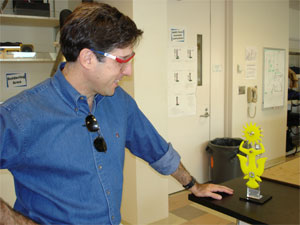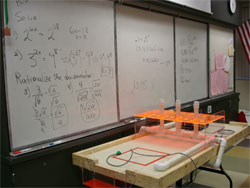Calit2 Supports Robotics Club at Preuss School UCSD
|
12.07.04 -- The Preuss School UCSD is a charter school on the edge of campus that serves talented, but economically disadvantaged, students in grades 6-12. Only in operation since 1998, Preuss already has earned impressive credentials: It graduated its first class last spring, and all 55 graduates have entered college. Another thing that puts the school on the map is its robotics club. It involves some 50 students in grades 9-12.
The Preuss Robotics club is led by Rob Mainieri, Allison Liewer, and Dan Rupert. Mainieri teaches honors algebra 2 and calculus, Liewer teaches math, and Rupert, just in his first year at Preuss, teaches math and pre-engineering.
"The club is slightly more female than male," says Rupert with a smile, and proudly points out that half the members have taken the pre-engineering class. He strongly encourages students in that class to join the club. The connection between his class and the club is tangible: This semester's students are designing and building a workbench, which then will be used to design and fabricate the robots in the club. Seeing their academic work being put to practical use in the club must be a strong draw to join.
|
Club leaders say they're grateful to Calit² for providing support for the costs of club materials, tools, and tutoring for club members involved in MAE 3. MAE 3 refers to a UCSD undergraduate mechanical and aerospace engineering class on robotics, taught by Nate Delson, known widely for the excitement and drama of its final "robot design contest."
"That's when all the teams compete with the robots they've designed and built," says Delson. "The robots have to accomplish a given task, and one team emerges the winner."
This year marks the first time that Preuss will participate head to head against the undergraduates. While the Preuss students are not enrolled in the class, the school has been given the opportunity to field four four-person teams against 35 teams from UCSD. The competition will take place December 8.
"The only prerequisite for my class is physics," says Delson. "So, with the demanding curriculum they have, Preuss students should be very competitive."
|
The MAE class provides first-hand experience of engineering, putting theories of physics in context. "The class exposes students to the joy of building a device that works and teaches them how engineering integrates theory with analysis," says Delson. Given that the class is part of the demanding technical curriculum at the Jacobs School of Engineering, what's surprising is that, in addition to the technical aspects of design, students spend significant effort in areas such as project management, teamwork, communication, and creativity - all real-world skills necessary to accomplish a goal.
The first three weeks of the class are devoted to individual projects designing and building pendulum clocks. Here the students gain experience with rapid prototyping. Then the focus switches to teamwork with seven-week team projects building the robots that compete in the final exam. "Students learn to make decisions, take responsibility, and apply engineering tools - just like in the real world," says Delson.
Topics covered during lectures include technical drawing, computer-aided design, application of physical principles to machine design, and effective management of the design process, including techniques for creativity, risk reduction, scheduling, and teamwork. In the MAE Design Studio, they learn fabrication skills, and, for their final report, oral and written communication is emphasized.
The Preuss students in MAE 3 are being mentored by two UCSD students, Willie Ho and Paul McGinty. The high school students design parts using CAD software and send those designs electronically to the college students who then cut out the parts using the rapid prototyping machine in the design studio.
McGinty, a third-year UCSD student majoring in aerospace engineering, says, "I'm here to help psych these students up about engineering. I'm surprised by how much they already know and how quickly they catch on and build things that work. I wish we'd had a program like this when I was in high school."
Ho, a fifth-year aerospace engineering major, says he'd like to see this program implemented on a larger scale so more students can experience hands-on science and engineering. "It's great to see these students seeking new skills by taking this class," says Ho. "It will be essential for the 2005 robotics season."
|
Members of the robotics club not only are mentored - they do mentoring themselves. Recently they hosted 10 local elementary and middle schools in the Lego League regional competition. The goal in this competition is for young people to learn concepts related to problem solving, building a device that works for an intended purpose, and computer programming. (Mentoring for this competition serves as a warm up for the FIRST Robotics Competition, for high school students, which comes later in the year.) The same set of parts - a Lego MindStorms kit - is used every year to make the robots, but each year, to keep the competition fresh, the robots are assigned a different purpose. The winners go on to the final competition at the Legoland amusement park just north of San Diego.
Like the Lego League competition, the MAE 3 class is good preparation for the FIRST competition because it teaches the design process and goal-oriented skills, and uses a similar timeline for delivering the final product. FIRST gives student teams a "pile of parts" and six weeks to design, build, and test their robots prior to competition.
But FIRST is not just about robots: Students who may be more interested in journalism or public relations, for example, can still participate and work on skills that are more meaningful to them.
This point underscores an unusual aspect of the club: the importance of communication skills. When the subjects for this story were first interviewed a few weeks ago, in fact, club members were writing a mission statement. The students also practice public speaking at competitions.
There's no mandate for the robotics activity to be purely academic, and, in fact, the FIRST competition formally encourages teams to develop financial and mentoring partnerships with companies so that students can benefit from real-world expertise. Club leaders say they'd love to involve engineering or high-tech companies in their activities because professional engineers would be great role models for the students.
With a 90% retention rate from one year to the next, the club is clearly meeting a need. It helps reinforce the value of studying math and physics, plus the students learn important life skills such as teamwork, achieving goals, and how to devise creative ways to overcome problems.





